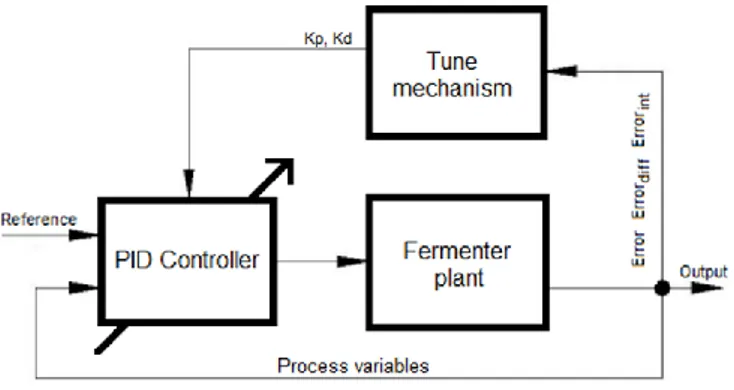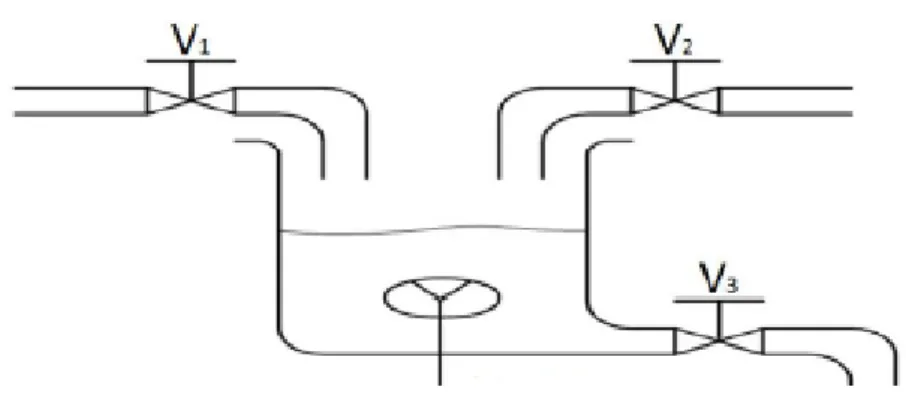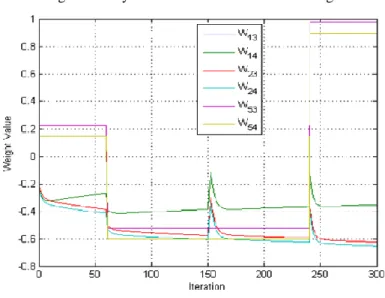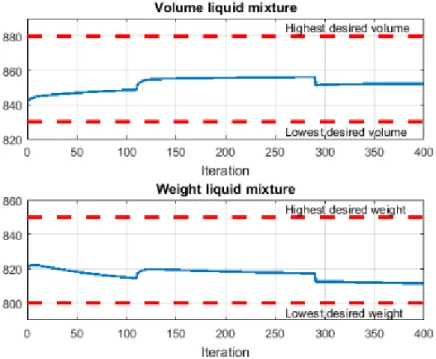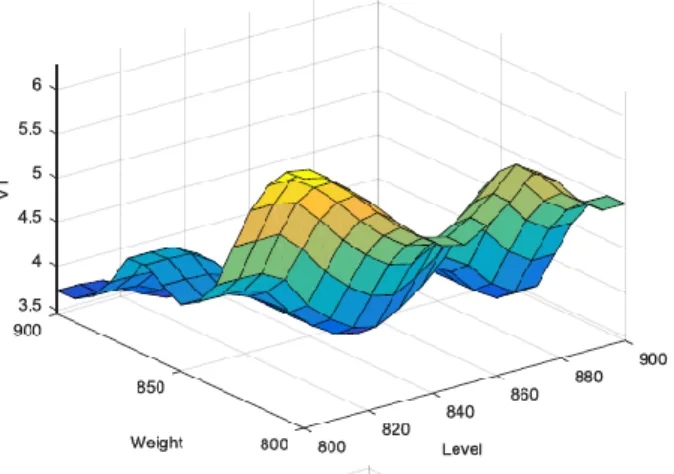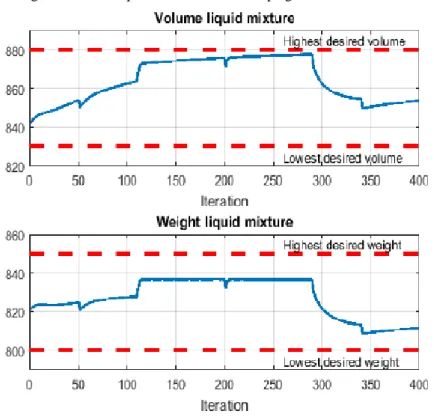Braz. J. of Develop., Curitiba, v. 6, n. 7, p. 52559-52578, jul. 2020. ISSN 2525-8761
Different Configurations and Applications of Dynamic - Fuzzy Cognitive Maps
Applied in Industrial Processes
Diferentes Configurações e Aplicações de Mapas Cognitivos Fuzzy Dinâmicos
Utilizados em Processos Industriais
DOI:10.34117/bjdv6n7-777
Recebimento dos originais: 08/06/2020 Aceitação para publicação: 29/07/2020
Marcio Mendonça
Doutor em Engenharia Elétrica e Inf. Industrial pela Universidade Tecnológica Federal do Paraná Instituição: Universidade Tecnológica Federal do Paraná, Campus Cornélio Procópio Endereço: Av. Alberto Carazzai, 1640, Cornélio Procópio, Paraná, Brasil, CEP: 86300-000
E-mail: mendonca@utfpr.edu.br Lucas Botoni de Souza
Mestre em Engenharia Mecânica, pela Universidade Tecnológica Federal do Paraná Instituição: Universidade Tecnológica Federal do Paraná, Campus Cornélio Procópio Endereço: Av. Alberto Carazzai, 1640, Cornélio Procópio, Paraná, Brasil, CEP: 86300-000
E-mail: lucsou@alunos.utfpr.edu.br Rodrigo Henrique Cunha Palácios
Doutor em Engenharia Elétrica pela Universidade de São Paulo
Instituição: Universidade Tecnológica Federal do Paraná, Campus Cornélio Procópio Endereço: Av. Alberto Carazzai, 1640, Cornélio Procópio, Paraná, Brasil, CEP: 86300-000
E-mail: rodrigopalacios@utfpr.edu.br Francisco de Assis Scannavino Junior Doutor em Física pela Universidade de São Paulo
Instituição: Universidade Tecnológica Federal do Paraná, Campus Cornélio Procópio Endereço: Av. Alberto Carazzai, 1640, Cornélio Procópio, Paraná, Brasil, CEP: 86300-000
E-mail: franciscojunior@utfpr.edu.br Wagner Fontes Godoy
Doutor em Engenharia Elétrica pela Universidade de São Paulo
Instituição: Universidade Tecnológica Federal do Paraná, Campus Cornélio Procópio Endereço: Av. Alberto Carazzai, 1640, Cornélio Procópio, Paraná, Brasil, CEP: 86300-000
E-mail: wagnergodoy@utfpr.edu.br Luiz Eduardo Pivovar
Graduado em Engenharia Mecânica pela Universidade Tecnológica Federal do Paraná Instituição: Instituto Federal do Paraná, Campus Jacarezinho
Endereço: Av. Dr. Tito, 801, Jardim Panorama - Jacarezinho, Paraná, Brasil, CEP: 86400-000 E-mail: luiz.pivovar@ifpr.edu.br
Braz. J. of Develop., Curitiba, v. 6, n. 7, p. 52559-52578, jul. 2020. ISSN 2525-8761 Uiliam Nelson Lendzion Tomaz Alves
Doutor em Engenharia Elétrica pela Universidade Estadual Paulista Instituição: Instituto Federal do Paraná, Campus Jacarezinho
Endereço: Av. Dr. Tito, 801, Jardim Panorama - Jacarezinho, Paraná, Brasil, CEP: 86400-000 E-mail: uiliam.alves@ifpr.edu.br
Ricardo Breganon
Doutor em Engenharia Mecânica pela Universidade de São Paulo Instituição: Instituto Federal do Paraná, Campus Jacarezinho
Endereço: Av. Dr. Tito, 801, Jardim Panorama - Jacarezinho, Paraná, Brasil, CEP: 86400-000 E-mail: ricardo.breganon@ifpr.edu.br
ABSTRACT
In this work, we present different configurations of Fuzzy Cognitive Maps (FCMs) controllers of three industrial processes. A first-order heat exchanger (Heatex) with a classic FCM compared with a Fuzzy Logic Controller (FLC) and the original PI controller designed by MatWorks®, using the Integral Absolute Error (IAE), the Integral Squared Error (ISE), settling time, overshoot and control signal. Besides, in this work, we present different configurations of Fuzzy Cognitive Maps (FCMs) controllers of three industrial processes. The second process is a fourth order alcoholic fermenter using DFCM applied in Industrial Mix controllers. The last process is one Mix controllers, it was presented in summary form with few details of the controller. However, it was possible to observe that it is adaptive and at least one campaign result with disturbances was presented. And, finally conclusions and future works will be presented.
Keywords: Heat exchanger, alcoholic fermenter, mixer tank, Fuzzy Cognitive Maps, adaptive control.
RESUMO
Neste trabalho, apresentamos diferentes configurações de controladores Mapas Cognitivos Fuzzy (FCMs) de três processos industriais. Um permutador de calor de primeira ordem (Heatex) com um FCM clássico comparado com um Controlador Lógico Fuzzy (FLC) e o controlador PI original concebido por MatWorks®, utilizando o Erro Integral Absoluto (IAE), a Integral do Erro Quadrático (ISE), o tempo de acerto, o excesso de disparo e o sinal de controle. Além disso, neste trabalho, apresentamos diferentes configurações de controladores de Mapas Cognitivos Fuzzy (FCMs) de três processos industriais. O segundo processo é um fermentador alcoólico de quarta ordem usando DFCM aplicado em controladores de Industrial Mix. O último processo é um controlador de mistura que foi apresentado de forma resumida com poucos detalhes do controlador. No entanto, foi possível observar que é adaptável e foi apresentado pelo menos um resultado de campanha com distúrbios. E, finalmente, serão apresentadas conclusões e trabalhos futuros.
Palavras-chave: Permutador de calor, fermentador alcoólico, tanque misturador, Mapa Cognitivo Fuzzy, controle adaptativo.
Braz. J. of Develop., Curitiba, v. 6, n. 7, p. 52559-52578, jul. 2020. ISSN 2525-8761 1 INTRODUCTION
In modern control systems, it is noticed that linear control becomes insufficient when the operating conditions of a system are not fixed. Thus, adaptive control is used. One of its objectives is to compensate variations in the parameters of nonlinear control systems which are, in general, an interconnection of components forming a configuration that produces a desired response (ÅSTRÖM and WITTENMARK, 2008; OGATA, 2010).
An alternative is to use heuristic models or semi-quantitative methods like Fuzzy Cognitive Maps (FCMs), which encode experts’ knowledge about the connections among the different parameters of the studied industrial process control. In other words, Fuzzy cognitive maps (FCMs) are a very convenient, simple, and powerful tool for simulation and analysis of dynamics systems (STACH et al., 2005).
These methods could be preferred to other alternatives as they allow modeling of complex system dynamics, without the need for capturing the functional relationships between concepts of the real system by means of complex mathematical equations.
In control systems, the main comparison between classical and fuzzy logic control provokes a general discussion of these two paradigms. Both in fuzzy and in FCM control, Figure 1 (a), linguistic terms represent the degree of knowledge of the operator on the analyzed real-world plant. This fact provides the possibility of controlling the process without having its mathematical model, unlike classical control, Figure 1 (b), which requires the model and its simplifying assumptions to the controller design, adding one more step in the paradigm, to prove the theorem stability (ROSS, 2010).
Braz. J. of Develop., Curitiba, v. 6, n. 7, p. 52559-52578, jul. 2020. ISSN 2525-8761 In this sense, FCMs can encode control tactics that are imprecise in nature, commonly expressed in linguistic terms, which is helpful when it is difficult to obtain a mathematical model of the process.
FCMs allow dealing with subjective and vague linguistic variables used by domain experts and handling uncertainties due to their approximate knowledge using Fuzzy Logic (PASSINO and YURKOVICH, 1998), such as the heuristic process used in this work.
There are many applications of FCMs in process control (MENDONÇA et al., 2013). In the work, authors used a Fuzzy-PID controller development of an alcoholic fermenter process proposed in Maher, (1995). Also, Lima and Serra, (2015) proposed a robust Fuzzy controller implemented for visualization and control of a thermal process.
In this work, the objective is to investigate the application of systems based on FCMs, designed using experts’ knowledge and compare their results with the more classical methods. We present three examples of industrial processes in this work. Intelligent control methods were used to tune the gains of a classical PID controller of an alcoholic fermenter, were directly applied as controllers in a heat exchange process (Heatex) and a Dynamic Fuzzy Cognitive Map (DFCM) with two weight’s adaptation methods: Hebbian learning algorithm (DFCM-Heb) and a weight-scheduling configuration (DFCM-WS).
The paper is organized as follows. Section II describes the processes and presents a brief background about Fuzzy Logic and FCM, presenting our contribution in the intelligent control area. In Section III, we show the obtained results and compare the other techniques. Finally, in Section IV, we outline some conclusions and directions for future work.
2 BACKGROUND AND PROCESSES’ DESCRIPTION
The original Heatex process used as a testbed in this work is found in the Matlab® documentation and in Mollon et al., (2017), among other works. It is described as a chemical reactor, called the stir-ring tank. In this process, the top piping provides liquid to be mixed in the tank. Then, this liquid must be maintained at a constant temperature from the variation of the amount of steam supplied to the heat exchanger (lower tube) by means of its control valve, which performs the control action through a PI controller. The disturbance sources in this process are the variations in the temperature of the input flow, given by a disturbance plant. The Heatex process was designed using a Fuzzy Logic Controller (FLC) as well as an FCM controller, analyzed in the feedback form. The block diagram of the system is depicted by Figure 2.
Braz. J. of Develop., Curitiba, v. 6, n. 7, p. 52559-52578, jul. 2020. ISSN 2525-8761
Figure 2 – Heatex block diagram.
The process is governed by two transfer functions: the mixer plant (Heatex) 𝑃𝐻, given by equations (1) and (2), and the disturbance plant 𝑃𝐷, given by equation (3), and the control is made through a set-point, as shown in Figure 2.
𝑃𝐻 = 121.3𝑠 + 1 (1)
𝑥𝑓 = 𝑙1cos 𝜃1 + 𝑙2cos(𝜃1+ 𝜃2) (2)
𝑃𝐷 = 125𝑠 + 1 (3)
The second example of an FCM controller is a fermenter processes; One aspect to be analyzed is the alcoholic fermenter process delimitation. Fermentation is a process of energy release in which there is no oxygen participation, and is used in industrial fermentation processes for manufacturing alcoholic beverages. Figure 3 shows a real alcoholic fermenter (a) and the simulated one used in this work (b). In Figure 3 (b), the Fin valve is responsible for the substrate flow in the tank, and Fout valve regulates the product’s flow out of the tank. These two valves are controlled by two independent PID controllers, which are adapted by the proposed tuning mechanisms, FCM-PID and Fuzzy-PID.
Braz. J. of Develop., Curitiba, v. 6, n. 7, p. 52559-52578, jul. 2020. ISSN 2525-8761 The fermentation process used in this work was inspired from the initial proposal by Maher, (1995), which has been a recurrent system for validation of different control architectures. More details can be found in Mendonça et al., (2013).
The process has four state variables: the concentrations (g/l) of substrate (S), the biomass (C), the product (P), and the volume (V) of the fermentation tank. In this process, four differential equations govern the system’s behavior, and are given by equations (4) to (8). The variables are the same as found in Mendonça et al., (2013).
𝑑𝑆 𝑑𝑡 = − 1 𝑌𝐶 𝑆⁄ 𝜇𝑐+ 𝐹𝑖𝑛 𝑉 𝑆𝑎 − 𝐹𝑜𝑢𝑡 𝑉 𝑆 (4) 𝑑𝐶 𝑑𝑡 = 𝜇𝑐− 𝐹𝑜𝑢𝑡 𝑉 𝑆 (5) 𝑑𝑃 𝑑𝑡 = 𝑌𝑃 𝑆⁄ 𝑌𝐶 𝑆⁄ 𝜇𝑐− 𝐹𝑜𝑢𝑡 𝑉 𝑃 (6) 𝑑𝑉 𝑑𝑡 = 𝐹𝑖𝑛− 𝐹𝑜𝑢𝑡 (7) 𝜇𝑐= 𝜇0 𝑆 𝐾𝑠+ 𝑆𝑎 (1 − 𝑃 𝑃𝑚 ) (8)
Important system dynamics factors are the large accommodation time and high correlation between the state variables. It is also noticed that it is a non-minimal phase system, as seen in Mendonça et al., (2013), with stabilization depending strictly on the correct concentrations to occur, thus being a MIMO control.
Some restrictions must be respected to ensure a correct fermentation setpoint campaign. For example, the concentration of biomass (C) should not exceed 8 g/l, while the substrate (S) should remain above 0.5 g/l, otherwise the reaction would end, and hence the process should be restarted again. Another restriction is the setpoint range of 10 to 50 g/l for P, according to the assumptions made in Mendonça et al., (2013).
The logic applied in the process was the Fuzzy, which was created by Zadeh, (1965), is an extension of Boolean logic, based on the theory of fuzzy sets, which is a generalization of the classical set theory. A key concept in fuzzy logic is membership functions. A fuzzy set A in the universe of discourse X is characterized by a membership function μ_A: X →[0,1]. A degree of zero means that the value is not in the set, a degree of one means that the value is totally representative of the set, and a degree confined between zero and one means the value is partially in the set.
The shape of the membership function is often chosen based on the advice of an expert or by statistical studies. A Sigmoid shape, Triangular, Trapezoidal, Gaussian or any other type can be
Braz. J. of Develop., Curitiba, v. 6, n. 7, p. 52559-52578, jul. 2020. ISSN 2525-8761 used. The concept of membership functions discussed above allows the definition of fuzzy natural language systems that make use of linguistic variables, where the universe of discourse of a variable is divided into a number of fuzzy sets with a linguistic description attributed to each one. In this work, Fuzzy systems were used as a way of representing the expert’s knowledge of the analyzed processes. A Fuzzy Cognitive Maps (FCM) is a soft computing technique that combines the advantages of Artificial Neural Networks (ANNs) and Fuzzy Logic, using existing knowledge and human experience to model complex systems (PAPAGEORGIOU, 2014). Due to their simplicity, support for ambiguous (Fuzzy) knowledge, they are applicable in many areas, such as medicine, engineering, software development, etc. FCMs emerged from Kosko’s, (1986) work, which expanded the concepts of Axelrod’s, (1976) and Tolman’s, (1948) previous Cognitive Maps works. FCMs introduced fuzziness to Cognitive Maps, by using numeric descriptions (fuzzy binaries) of causal influences instead of positive or negative symbols.
In a FCM, the value 𝐴𝑖(𝑘+1) of each concept 𝐶𝑖 at iteration 𝑘 + 1 is calculated as a function of the sum of 𝐴𝑖(𝑘) at iteration 𝑘, with the product of 𝐴𝑗(𝑘) of the concept 𝐶𝑗 by 𝑤𝑖𝑗, which is the value of the causal link between 𝐶𝑗 and 𝐶𝑖, given in the range [-1 1]. The mathematical representation
of FCM inference is given by equation (9).
𝐴𝑖(𝑘+1) = 𝑓(𝐴𝑖(𝑘) + ∑ 𝐴𝑗(𝑘) ∗ 𝑤𝑗𝑖) 𝑁
𝑗=1 𝑗≠𝑖
(9)
In (9), 𝑓(. ), denotes a threshold function like sigmoid to squash the values within the range [0 1], as shown in equation (10), where λ is a real positive number, which determines the steepness of 𝑓(. ), and 𝑥 is the value of 𝐴𝑖 at the equilibrium point.
𝑓(𝑥) = 1⁄(1 + 𝑒−𝜆𝑥) (10)
It is not scope of this work to analyze the stability of the FCM. However, these equations combined suggest stability similarly to the work from Boutalis and Kottas (2009), which shows that threshold sigmoid functions have interval previous defined and are continuous differentiable. Also, the calculated values and causes their convergence to the same specific value (ELENI and PETROS, 2017).
Braz. J. of Develop., Curitiba, v. 6, n. 7, p. 52559-52578, jul. 2020. ISSN 2525-8761 The stability initials analysis and results have been presented by the same authors (ELENI and PETROS, 2017). This study was done by using an appropriately defined contraction mapping theorem and the non-expansive mapping theorem. In other way, Kosko examined Associative Memories stability by identifying a Lyapunov or energy function with associative memory states (Boutalis and Kottas, 2008; KOSKO, 1988; MARTCHENKO et al., 2003).
For the Heatex control, a Fuzzy controller (FLC) and an FCM controller were developed, and were compared to the original PI controller in Matlab®, similarly as seen in Mollon (2017), which the FCM controller was compared with ANN-FCM and other techniques.
The FCM controller was created at first, considering errors in the same way that in the PID controller, which are namely the error (Error) and the differential error (Errordiff) for each iteration. Due to the low complexity of this system, it was unnecessary to use the error integral as expected.
For the FCM controller, Simulink® was used to modify the structure of the controller used in Puheim et al., (2015).
The causal relationships of the FCM were defined heuristically. The causal weight values were chosen as W13=0.75 and W23=0.2.
The second step was to create the FLC. In this process, the rule base used was the same as the one proposed by Passino and Yurkovich (1998), Timothy J. Ross (2010), to control an inverted pendulum, with 25 rules, three triangular (center) and two trapezoidal (borders) pertinence functions. The inputs, like in the FCM controller, are Error and Errordiff and the output is the control signal.
System simulations were run in Simulink® for the FCM and FLC controllers and data was collected for the Integral Absolute Error (IAE), Integral Squared Error (ISE), 2% settling time (Ts) and overshoot analysis in order to compare the different alternatives.
We designed an adaptive PID controller with FCM and Fuzzy adjustment mechanisms using Maher’s (1995) approach. Subsequently, as in the Heatex process, the results were compared with the PID controller used as the basis for the tuning mechanisms.
In this work, we used a maximum tank volume (V) of 4.75 l and a minimum volume of 1 l. Accordingly, if the former case occurs, the Fin valve is completely closed, and if the latter case occurs,
the valve Fout is closed (MENDONÇA et al., 2013). As discussed in this work, equations (4) to (8)
Braz. J. of Develop., Curitiba, v. 6, n. 7, p. 52559-52578, jul. 2020. ISSN 2525-8761
Figure 4 –Auto tune architeture
The architecture shown in Figure 4 was used as a tuning mechanism for the both FCM-PID and Fuzzy-PID controllers presented in this work. The variables Error, Errorint, and Errordiff represent the errors related to the gain parameters of the PID, which are respectively error, integral error and differential error. The tuning mechanism interprets the errors coming from the parameters of the controller and, from the analysis proposed for each mechanism, applies multipliers to the proportional (Kp) and derivative (Kd) PID gains, adapting their values at each iteration.
For a better validation among the tuning mechanisms used, a fermentation campaign was developed (group of setpoint values to be followed) that can describe a real fermentation campaign according to the restrictions imposed in this work.
The initial step in the development was the tuning of the initial parameters of the PID controller: Kp, Kd and Ki, through the heuristic and process analysis. The values reached are Kp=2,
Kd=4.95 and Ki=0.35.
The first tuning mechanism to be developed was the FCM-PID, using a domain expert’s knowledge of the process. The developed FCM is shown in Figure 5, where concepts 4 and 5 correspond to the Kp and Kd gain multipliers to be applied in the PID. In this work, the relation
between computational cost and results’ improvement did not justified the use of Ki gain multipliers.
From the expert’s knowledge employed in the FCM, it was noticed that there is a weak negative influence in all relationships. The overall FCM weights are: W14=-0.28, W15=-0.30,
W24=W25=-0.25, W34=-0.15 and W35=-0.17.
The Fuzzy-PID mechanism had its rules and membership functions also adjusted heuristically, based on the relationships of the FCM-PID, with the same concepts used in the FCM.
The FLC system used was a weighted Mamdani (MIAO et al., 2001) with 3 inputs (Error, Errordiff and Errorint), 2 outputs (Kp and Kd multipliers) and 18 rules. The pertinence functions were
created to reach three ranges of values, namely “small”, “medium” and “large” for input and outputs, using trapezoidal functions at the edges and a triangular one in the center.
Braz. J. of Develop., Curitiba, v. 6, n. 7, p. 52559-52578, jul. 2020. ISSN 2525-8761
Figure 5 – FCM used in alcoholic fermenter process
Figure 6 – Fuzzy surfaces for the fermenter process
The inputs (absolute errors) range from 0 to 1 (100% positive error). The Kp output range is
[0 1.5] and Kd is [0 2], both adjusted heuristically, obtaining the Fuzzy surfaces, two of which are
shown in Figure 8.
In this work the FCM corresponds to a simple acyclic graph, different from Kosko's (1986) original proposal. In this way, according to Miao et al. (2001) and Mendonça et al. (2013) the construction of large cognitive maps by steps always generates smaller maps usually acyclic, which correspond to well de-fined cause-effect relations. Thus, based on the concepts of repulsive artificial pheromones, this work presents an optimization of the robots' trajectory, thus increasing the search area without increasing the distance traveled. In other words, when a robot detects high concentrations of pheromones, whether they are left by the other robots or itself, it will deflect its course so as not to become trapped in relatively more difficult navigational zones such as narrow corridors.
Braz. J. of Develop., Curitiba, v. 6, n. 7, p. 52559-52578, jul. 2020. ISSN 2525-8761 Another proposal for control via FCM is to control an industrial mixer that due to the low complexity of the FCM mathematics for its inference allowed the controller to be shipped in a low cost controller, such as Arduino and PIC for example. Figures 9 and 10 show the process and the Adaptive FCM due to its weight adjustment being dynamic with the HEBB rule.
3 MIXER PROCESS DESCRIPTION
To demonstrate the evolution of the proposed technique (DFCM) we will use a case study well known in the literatureas seen in (SOUZA et al., 2017; MATSUMOTO et al., 2013; MENDONÇA et al.,2016). This case was selected as shown Figure 7.
Figure 7 – Industrial Mixer Process
Valves (V1) and (V2) insert two different liquids (specificgravities) in the tank. During the
reaction of the two liquids, anew liquid characterized by its new specific gravity value is produced. At this time, the valve (V3) empties the tank inaccordance with a campaign output flow, but the liquid
mixture should match the specified levels of the volume and specific gravity. Although being relatively simple, this process is a TITO (Two Inputs and Two Outputs) type with coupled variables. To establish the quality of the control system of the produced fluid, a weighting machine placed in the tank measures the specific gravity of the liquid produced. When the value of the measured variable G, liquid mass,reaches the range of values between the maximum and minimum [Gmin, Gmax] specified, the desired mixed liquid is ready. The removal of liquid is only possible when the volume (V) is in a specified range between the values [Vmin and Vmax]. The control consists
to keep these two variablesin their operating ranges, as:
𝑉𝑚𝑖𝑛 < 𝑉 < 𝑉𝑚𝑎𝑥 (11)
Braz. J. of Develop., Curitiba, v. 6, n. 7, p. 52559-52578, jul. 2020. ISSN 2525-8761 In Figure 8, it is possible to observe that we have three valves, two input (V1 and V2) for the
input of two different liquids, such as water and milk in a food process and one with outflow (V3).
Two variables must be controlled by range, the weight and volume of the mixture; which makes the MIMO process.
Figure 8 – Industrial Mixer Controller
As the DFCM of this process was adaptive, a weight variation test was carried out to ensure that they were in the range of [-1, 1], according to the original proposal (KOSKO, 1986). Figure 9 shows the variation of the weights tuned during the campaign.
Figure 9 – Dynamic variation of controller weight
Another important factor was the possibility to embark the tank controller in FCM and the equations in Matlab®. Figures 10 and 11 show Matlab® - Arduino comunication and this cycle respectively.
The similarity with the fermentor controller is emphasized, however this controller has its weights adjusted offline by a genetic algorithm with selective population and online by the Hebb rule
Braz. J. of Develop., Curitiba, v. 6, n. 7, p. 52559-52578, jul. 2020. ISSN 2525-8761 that tunes the weights according to the process error. This dynamic tuning can be classified as an adaptive controller (ÅSTRÖM and WITTENMARK, 2008).
Figure 10 – Arduino connected to the computer showing a campaign
Figure 11 – Matlab process - Arduino controller
To establish a correlation and a future comparison between techniques, a Fuzzy controller was also developed. The Fuzzy rules base uses the same heuristic control strategy and conditions. Fuzzy logic has proved being able to provide satisfactory non-linear controllers even when only the nominal plant model is available, or when plant parameters are not known with precision (ROSS, 2010; BEHROOZ et al., 2018; MAITI, 2008). Fuzzy Control is a technique used for decades, especially in process controlling (GLYKAS, 2010), (PAPAGEORGIOU, 2014). The Figure 12 shows an example of a campaign with disturbances for the campaign in Figure 15. After the brief presentation of (FLC) Mandani.controller fuzzy. Classic controller for validating this DFCM application.
Braz. J. of Develop., Curitiba, v. 6, n. 7, p. 52559-52578, jul. 2020. ISSN 2525-8761
Figure 12 – Valves and Results of the DFCM Controller.
It is a motivation to validate DFCM, so in this study it was used the same approach for two controllers, with two different formalisms. It is not in the scope to discuss the development of the Fuzzy controller, but some details of the structure are pertinent: functions are triangles and trapezoidal and 6 rules are considered in its base. The Fuzzy controller surfaces are shown in Figure 13. Moreover, the rules are symmetric and similar by two output valves; in this specific case, the surface of valve 1 is the same as in valve 2. The base rules and its respective weighted weights are:
1. If (Level is low) then (V1 is medium) (V2 is medium) (1);
2. If (Level is medium) then (V1 is low) (V2 is low) (1);
3. If (Level is high) then (V1 is low) (V2 is low) (1);
4. If (Weight is low) then (V1 is high) (V2 is high) (1);
5. If (Weight is medium) then (V1 is low) (V2 is low) (0.5);
6. If (Weight is high) then (V1 is low) (V2 is low) (1);
7. If (ValveOut is high) then (V1 is high) (V2 is high) (0.5);
8. If (ValveOut is medium) then (V1 is medium) (V2 is medium) (0.5);
Braz. J. of Develop., Curitiba, v. 6, n. 7, p. 52559-52578, jul. 2020. ISSN 2525-8761
Figure 13 – Non-linearity of the process with an example of a Fuzzy surface
In Figure 14 shows the structure of the Mandani fuzzy controller, with the same inputs and outputs as DFCM.
Figure 14 – Non-linearity of the process with an example
In Figure 15 shows the results of the campaign with disturbances obtained by FLC Mamdani to observe the controllers' behavior in adverse situations.
Braz. J. of Develop., Curitiba, v. 6, n. 7, p. 52559-52578, jul. 2020. ISSN 2525-8761 Figure 16 shows the results of the FLC control actions for the campaign in Figure 15.
Figure 16 – Example FLC-Mamdani campaign with disturbances
The Mandani Fuzzy Logic controller was able to set the variables in the predetermined ranges, but with a greater variation than the proposed adaptive DFCM.
Table 1 shows the quantitative results of this disturbed experiment.
Table 1 - Quantitative results with disturbances
DFCM FUZZY LOGIC
Max-min Max-min
Campaign 1 2 1 2
Volume mix (ml) 13.82 14.79 35.51 38.12
Weight mix (mg) 14.69 14.31 28.02 20.64
Braz. J. of Develop., Curitiba, v. 6, n. 7, p. 52559-52578, jul. 2020. ISSN 2525-8761
Figure 17 – Matlab results with time processing
4 RESULTS AND DISCUSSION
In short, this section, we discuss the results of the application of DFCM in three different industrial processes. With different complexities and configurations. From the Heatex process (FCM simulink), less complex to the Fermenter, certainly the most complex process. Results compatible with the FLC showed advantages of the application of DFCM. In particular, in the process of the industrial mixer with a campaign with disturbances. Which showed an adaptive DFCM with less computational complexity. What enabled embedded in Arduino (low cost processing and value controller).
5 CONCLUSIONS
In the control of the mixer the results were satisfactory because the variables were within the desired ranges even with disturbances in the process. In addition, even with dynamic adjustment, the value of the weight range did not detract from Kosko's initial proposal.
In the case of the alcoholic fermenter process, the FCM-PID mechanism obtained the best responses according to the analyzed parameters, obtaining the lowest values in all of them considering the analyzed campaign.
Finally, these aspects suggest that the DFCM control can be successfully used in autonomous robots, since this controller presented optimized results compared to FLC.
Future research will focus on exploiting the potential of the soft computing techniques in industrial process control, including disturbances, new setpoint and others changes in the processes addressed. Three important research topics are considered. First, we would like to embed all the developed controllers in other platforms, like Raspberry PI, Toradex etc., in order to verify the low computational complexity, time response and software portability of the FCM-based controllers. Secondly, addressing a real-time MIMO controller for temperature and level in a real tank prototype, for example. The third topic is the stability analysis of the FCMs, an important step for further
Braz. J. of Develop., Curitiba, v. 6, n. 7, p. 52559-52578, jul. 2020. ISSN 2525-8761 investigation. Finally, future comparisons with other intelligent, classic, robust and modern control techniques can be investigated.
ACKNOWLEDGEMENTS
The authors would like to thank to the Universidade Tecnológica Federal do Paraná, Cornélio Procópio, and Instituto Federal do Paraná, Jacarezinho for the development of this work.
Braz. J. of Develop., Curitiba, v. 6, n. 7, p. 52559-52578, jul. 2020. ISSN 2525-8761 REFERENCES
ÅSTRÖM K. J. and WITTENMARK, B. Adaptive Control, 2nd ed. USA: Dover Publications, 2008. OGATA, K. Modern Control Engineering, vol. 17. 2010.
STACH, W.; KURGAN, L.; PEDRYCZ, W. and REFORMAT, M. “Genetic learning of fuzzy cognitive maps,” Fuzzy Sets Syst., vol. 153, no. 3, pp. 371–401, 2005, doi: 10.1016/J.FSS.2005.01.009.
ROSS, T. J. Fuzzy logic with engineering applications, 3rd ed. New Mexico, USA: John Wiley & Sons, 2010.
PASSINO, K. M. and YURKOVICH, S. Fuzzy Control, 1st ed. Menlo Park, CA, USA: Addison Wesley, 1998.
MENDONÇA, M.; ANGELICO, B.; ARRUDA, L. V. R. and NEVES-JR, F. “A dynamic fuzzy cognitive map applied to chemical process supervision,” Eng. Appl. Artif. Intell., vol. 26, no. 4, pp. 1199–1210, 2013, doi: 10.1016/j.engappai.2012.11.007.
MAHER, M. “Modélisation et élaboration d’algorithmes d’estimation et de commande: application à un bioprocédé,” 1995.
LIMA, F. and SERRA, G. “Fuzzy PID controller multiobjective genetic design,” 2015 IEEE 10th Conference on Industrial Electronics and Applications (ICIEA). pp. 1506–1511, 2015, doi: 10.1109/ICIEA.2015.7334347.
MOLLON, M. F.; KANEKO, E. H.; CHAVES, W. D. S. NIRO, L. and MONTEZUMA, M. A. F. “Control of Non-linear Equation of Submarine Using PI-like Fuzzy Controller,” Int. J. Adv. Eng. Res. Sci., vol. 6495, no. 12, pp. 85–91, 2017, doi: 10.22161/ijaers.4.12.15.
ZADEH, L. A. “Fuzzy Sets,” Inf. Control, vol. 353, pp. 338–353, 1965, doi: http://dx.doi.org/10.1016/S0019-9958(65)90241-X.
PAPAGEORGIOU, E. I. Fuzzy Cognitive Maps for Applied Sciences and Engineering. Heidelberg: Springer-Verlag Berlin Heidelberg, 2014.
KOSKO, B. “Fuzzy cognitive maps,” Int. J. Man. Mach. Stud., vol. 24, no. 1, pp. 65–75, 1986, doi: 10.1016/S0020-7373(86)80040-2.
AXELROD, R. Structure of decisions: the cognitive maps of political elites, 1st ed. Princeton, NJ, USA: Princeton University Press, 1976.
TOLMAN, E. C. “Cognitive maps in rats and men,” Psychol. Rev., vol. 55, no. 4, pp. 189–208, 1948, doi: 10.1037/h0061626.
BOUTALIS, Y.; KOTTAS, T. L. and CHRISTODOULOU, M. “Adaptive estimation of fuzzy cognitive maps with proven stability and parameter convergence,” IEEE Trans. Fuzzy Syst., vol. 17, no. 4, pp. 874–889, 2009, doi: 10.1109/TFUZZ.2009.2017519.
Braz. J. of Develop., Curitiba, v. 6, n. 7, p. 52559-52578, jul. 2020. ISSN 2525-8761 ELENI, V. and PETROS, G. “New Concerns on Fuzzy Cognitive Maps Equation and Sigmoid Function,” 25th Mediterranean Conference on Control and Automation (MED), 2017, pp. 1113– 1118.
BOUTALIS, Y. and KOTTAS, T. “On the Existence and Uniqueness of Solutions for the Concept Values in Fuzzy Cognitive Maps,” in 47th IEEE Conference on Decision and Control, 2008, pp. 98–104.
KOSKO, B. “Bidirectional Associative Memories,” IEEE Trans. Syst. Man Cybern., vol. 18, no. 1, pp. 49–60, 1988, doi: 10.1109/21.87054.
MARTCHENKO, M. A. S.; ERMOLOV, I. L.; GROUMPOS, P. P. P.; PODURAEV, P. J. V and STYLIOS, C. D. “Investigating Stability Analysis Issues for Fuzzy Cognitive Maps,” in 11th Mediterranean Conference on Control and Automation - MED’03, 2003, pp. 1–7.
PUHEIM, M.; VAŠČÁK, J. and MADARÁSZ, L. “A proposal for Multi-Purpose Fuzzy Cognitive Maps library for complex system modeling,” in SAMI 2015 - IEEE 13th International Symposium on Applied Machine Intelligence and Informatics, 2015, no. November, pp. 175–180, doi: 10.1109/SAMI.2015.7061871.
MIAO, Y.; LIU, Z.-Q.; SIEW, C. K. and MIAO, C. Y. “Dynamical cognitive network - an extension of fuzzy cognitive map,” IEEE Trans. Fuzzy Syst., vol. 9, no. 5, pp. 760–770, 2001, doi: 10.1109/91.963762.
MATSUMOTO, D. E.; MENDONÇA, M.; ARRUDA, L. V. R. and PAPAGEORGIOU, E. I. “Embebed Dynamic Fuzzy Cognitive Maps applied to the Control of an industrial mixer,” in XI Simpósio Brasileiro de Automação Inteligente (SBAI), 2013, no. Sbai.
MENDONÇA, M.; NEVES-JR, F.; ARRUDA, L. V. R. de; PAPAGEORGIOU, E. I. and. CHRUN, I. R “Embedded Dynamic Fuzzy Cognitive Maps for Controller in Industrial Mixer,” in 8th International KES Conference on Intelligent Decision Technologies KES-IDT-16, 2016, pp. 1– 10.
BEHROOZ, F.; MARIUN, N.; MARHABAN, M. H.; RADZI, M. A. M. and RAMLI, A. R. “Review of control techniques for HVAC systems-nonlinearity approaches based on fuzzy cognitive maps,” Energies, vol. 11, no. 3, pp. 1–41, 2018, doi: 10.3390/en11030495.
MAITI, D.; ACHARYA, A.; CHAKRABORTY, M.; KONAR, A. and JANARTHANAN, R. “Tuning PID and PI D Controllers using the Integral Time Absolute Error Criterion,” 2008 4th Int. Conf. Inf. Autom. Sustain., pp. 1–6, 2008, doi: 10.1109/ICIAFS.2008.4783932.
GLYKAS, M. Fuzzy Cognitive Maps: Advances in Theory, Methodologies, Tools and Applications, vol. 247. Heidelberg: Springer-Verlag Berlin Heidelberg, 2010.
NEDJAH, N. and SILVA JUNIOR, L. “Review of methodologies and tasks in swarm robotics towards standardization,” Swarm Evol. Comput., vol. 50, no. October 2017, pp. 1–26, 2019, doi: 10.1016/j.swevo.2019.100565.


